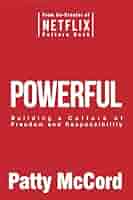In the ever-evolving landscape of leadership literature, few voices resonate with the raw honesty and practical wisdom found in Patty McCord’s work. Her book, Powerful, promises to challenge conventional management doctrines and invite readers into a candid exploration of what truly drives high-performing teams. This review delves into the core themes and provocative ideas McCord presents, assessing how her insights might unlock new perspectives for leaders navigating today’s complex organizational challenges.
Unlocking the essence of Leadership: Exploring the Core Themes in Patty McCord’s Powerful Insights
At the heart of Patty McCord’s insights lies a refreshing perspective on leadership-one that challenges traditional corporate norms and champions radical honesty,accountability,and empowerment. Rather than clinging to hierarchical control, McCord advocates for creating environments where trust and clarity flourish, enabling teams to operate with authentic collaboration and shared responsibility. Her approach dismantles the myth of leadership as a position of authority and instead presents it as a role of facilitation, where leaders nurture talent and foster continuous growth.
Several core themes consistently emerge from her work, resonating deeply with today’s dynamic business landscape:
- Radical Candor: Embracing candid conversations to build stronger relationships and enhance team performance.
- Continuous Feedback: Moving beyond annual reviews to real-time,constructive dialogue.
- Empowerment Over Control: Trusting employees to make decisions and take ownership.
- Embracing Change: Encouraging adaptability and learning as constants in leadership practice.
| Core Theme | Leadership Impact |
|---|---|
| Radical Candor | Builds trust and clarity |
| Continuous Feedback | Accelerates growth and agility |
| empowerment Over Control | Fosters innovation and commitment |
| Embracing Change | keeps teams resilient and relevant |
how Honest Conversations Can Transform Workplace Culture and Drive Organizational Success
The ripple effects of honest communication extend far beyond individual interactions. Organizations that embrace truthfulness tend to outperform their competitors by building stronger,more collaborative teams. Consider the following benefits that stem from fostering candid conversations:
- Enhanced problem-solving: Challenges are addressed swiftly, with diverse perspectives contributing to well-rounded solutions.
- Stronger accountability: Clear expectations and feedback promote responsibility and continuous betterment.
- Increased engagement: Employees feel valued, leading to higher motivation and retention rates.
| Impact Area | Organizational Outcome |
|---|---|
| Trust | Boosted collaboration and morale |
| Transparency | faster decision-making |
| Feedback | Continuous growth and agility |
The Role of radical candor in Building Trust and Enhancing Team Performance
Radical Candor is more than just a management buzzword; it’s a transformative practice that redefines how leaders engage with their teams. At its core, it encourages leaders to blend direct honesty with genuine care, creating an environment where feedback flows freely without fear or resentment. This authenticity not onyl dismantles communication barriers but also nurtures a culture of trust where every team member feels seen and valued. When people are confident that their leaders and peers are being candid out of respect rather than judgment, collaboration flourishes and innovation becomes a natural byproduct.
This approach manifests tangible benefits in team dynamics and productivity. Consider the following key impacts of embracing radical candor:
- Accelerated problem Solving: Honest conversations bring underlying issues to the surface faster, allowing teams to address challenges before they escalate.
- Enhanced Accountability: Clear expectations and candid feedback ensure every member understands their contributions and areas for growth.
- Stronger Relationships: Mutual respect deepens bonds, fostering loyalty and reducing turnover.
| Trait | Outcome | Impact on Team |
|---|---|---|
| Empathy in Feedback | builds trust | Increased morale |
| Direct Communication | Clarity of goals | Improved focus |
| consistent Check-ins | Ongoing growth | Higher performance |
Reimagining Employee Accountability: Lessons from Patty McCord on Empowering Teams
To foster this kind of empowered accountability,McCord emphasizes several vital principles,including:
- Radical honesty: Encouraging candid feedback that elevates performance without alienation.
- Clear context: Ensuring every team member understands not just what to do,but why it matters.
- Continuous dialogue: Maintaining open channels to align expectations and resolve issues promptly.
When implemented thoughtfully, thes elements not only drive results but cultivate resilient cultures where accountability is owned rather than imposed.
| Traditional Accountability | McCord’s Approach |
|---|---|
| Top-down monitoring | Peer-driven responsibility |
| Focus on compliance | focus on contribution |
| Fear of failure | Learning from failure |
| Infrequent feedback | Ongoing, honest dialogue |
Practical Steps to Implement Transparent Feedback Loops That Foster Growth and Innovation
Creating an environment where feedback flows openly requires intentional design. Start by establishing safe channels that encourage honest dialogue without fear of judgment-weather through regular one-on-ones, anonymous surveys, or real-time chat tools. Leaders must model vulnerability by inviting criticism and demonstrating how it shapes their decisions. Embedding feedback into daily routines, such as closing meetings with a quick “what went well and what could improve,” transforms feedback from an annual event into a living, breathing element of your company’s culture.
Practicality is key in translating feedback into growth. Consider a simplified framework like the one below that breaks down feedback implementation into actionable stages.This not only clarifies expectations but also creates accountability and celebrates progress, ensuring ideas evolve into measurable innovation.
| Stage | Action | Goal |
|---|---|---|
| Collect | Encourage open, frequent feedback across teams | Capture fresh perspectives |
| Reflect | Analyze and discuss feedback in team meetings | Identify patterns and opportunities |
| Act | Implement changes with clear ownership | Drive continuous improvement |
| Review | Measure impact and share learnings | Celebrate wins and adjust course |
Navigating Challenges of Traditional Leadership Models with McCord’s Bold Strategies
Traditional leadership structures often rely on rigid hierarchies, slow decision-making, and a culture that discourages transparency and innovation. Patty mccord’s approach challenges these norms by advocating for radical honesty, continuous feedback, and a focus on team empowerment rather than top-down control. her strategies encourage leaders to foster environments where transparency is not just welcomed but expected,and where every individual’s contribution is critically valued. This shift not only improves collaboration but also accelerates adaptability in rapidly changing markets.
Implementing McCord’s principles requires a departure from conventional metrics of success. Instead of quarterly targets that may stifle creativity, she promotes a culture centered on trust, accountability, and intrinsic motivation. Key elements include:
- Eliminating unneeded bureaucracy to streamline communication and decision-making.
- Encouraging open dialogue so that feedback flows freely in all directions.
- Prioritizing team alignment over strict role definitions to keep everyone oriented toward shared goals.
| Traditional Model | McCord’s Strategy |
|---|---|
| Hierarchical decision-making | Distributed leadership and autonomy |
| Annual performance reviews | Continuous, real-time feedback |
| Fixed job descriptions | Flexible roles based on team needs |
The Impact of removing Formal hierarchies on Collaboration and Creative Problem-Solving
Stripping away traditional hierarchies creates a fertile ground where collaboration flourishes and creativity blooms. Patty McCord advocates for dismantling rigid reporting lines to foster an environment where ideas flow freely and ownership is shared, rather than hoarded. In such setups, teams navigate projects as interconnected units rather than segmented silos, allowing diverse perspectives to merge and spark innovative solutions. This organic exchange reduces bottlenecks and eliminates the “approval treadmill,” empowering team members to act swiftly and decisively without waiting for every nod from above.
Moreover, the impact isn’t just cultural but measurable. When formal hierarchies are removed, organizations often witness enhanced problem-solving capabilities, accelerated decision-making, and increased job satisfaction. Below is a snapshot comparison of typical organizational traits before and after flattening the hierarchy, showcasing McCord’s insights in action:
| Aspect | Traditional Hierarchy | Flat Structure |
|---|---|---|
| Decision Speed | Slow, multi-layer approvals | fast, team-driven choices |
| Idea Flow | Filtered through levels | Open, cross-functional sharing |
| Accountability | Individual, role-based | Collective, project-focused |
| Problem-solving | Isolated by department | Collaborative, diverse perspectives |
Balancing Freedom and Responsibility: A Closer Look at McCord’s Approach to Employee Autonomy
at the core of McCord’s beliefs lies a radical trust in employees, emphasizing that true autonomy flourishes only when coupled with clear, shared expectations. She challenges traditional management paradigms by suggesting that freedom without responsibility leads to chaos,while responsibility without freedom stifles innovation. By fostering a culture where employees are empowered to make decisions but remain fully accountable for outcomes, McCord crafts an environment that promotes both creativity and discipline. This balance is not static; rather, it is a dynamic interplay that requires constant calibration by leaders willing to embrace transparency and tough conversations.
Her approach can be distilled into key principles that guide organizations toward lasting autonomy:
- Trust over Control: Shifting from micromanagement to trust-based relationships.
- Radical Transparency: making expectations and feedback open and honest at all levels.
- Accountability Mechanisms: Establishing clear metrics for responsibility alongside freedom.
- Continuous Learning: Encouraging ongoing reflection and adaptation to sustain the balance.
| Freedom Aspect | Corresponding Responsibility |
|---|---|
| decision-Making | outcome Ownership |
| Flexible Scheduling | Meeting Deadlines |
| creative Experimentation | Learning from Failures |
Leveraging Data and Real-Time metrics to Make Smarter Leadership Decisions
In today’s rapidly shifting business landscape, leaders who harness the power of data and real-time metrics position themselves to respond with agility and precision. Patty McCord’s insights highlight the importance of building leadership strategies rooted not in intuition alone, but in solid, actionable evidence. By integrating real-time data streams into decision-making processes, leaders can spot emerging trends, identify potential risks early, and tailor their approaches to evolving team dynamics. This transparent, data-driven approach fosters a culture of accountability, where decisions are continuously informed and refined rather than stagnant or based on past assumptions.
Key benefits of leveraging data include:
- Enhanced clarity on team performance metrics
- Faster problem detection and resolution
- Objective evaluation of leadership initiatives
- Improved alignment between organizational goals and daily activities
| Metric | Leadership Insight | Impact |
|---|---|---|
| Employee Engagement | Reveals team morale and motivation levels | informs personalized support and growth opportunities |
| Project Velocity | Tracks pace of deliverables and bottlenecks | Optimizes resource allocation and timelines |
| Customer Feedback | Identifies satisfaction gaps and innovation needs | Guides strategic pivots and service improvement |
Recommended Practices for Cultivating a Culture of Continuous Improvement Inspired by Powerful
at the heart of fostering a culture that thrives on continuous improvement lies the commitment to embracing radical transparency. Patty McCord champions the idea that organizations should openly share both successes and failures, transforming every challenge into a learning prospect. Encouraging candid feedback and empowering teams to question norms can dismantle bureaucratic inertia, replacing it with a dynamic environment where innovation flourishes. By normalizing conversations around growth, companies tap into collective wisdom, forging a path where each individual actively contributes to sharpening processes and elevating performance.
Another pivotal practice involves creating frameworks where experimentation is not only allowed but celebrated. This means structuring goals that promote iterative advancement, paired with the freedom to pivot without stigma. Implementing clear, measurable metrics alongside personal accountability ensures that improvements are both meaningful and sustainable. Consider the following model that distills McCord’s approach into actionable steps:
| Practice | Focus Area | Outcome |
|---|---|---|
| Radical Transparency | Open Communication | Trust and Engagement |
| Encouraging Feedback | Continuous Learning | Enhanced Skills |
| Experimentation Freedom | Innovation | Agile Improvement |
| clear Metrics | Accountability | Measurable growth |
Integrating Patty McCord’s leadership Principles into Your Organization: Tips for Sustainable Change
to embed Patty McCord’s leadership ethos into your organization, start by fostering a culture of radical honesty. Encourage open feedback loops where employees at all levels are trusted to share unvarnished truths. This transparency dismantles fear and fosters innovation. Embrace the idea that everyone should be treated like an adult – empower your team with clarity about expectations and the freedom to own outcomes. Encouraging autonomy doesn’t mean relinquishing responsibility; instead, it creates a dynamic environment where creativity and accountability thrive side by side.
Implementing sustainable change demands practical steps rooted in clear communication and consistent reinforcement. Create forums-whether weekly stand-ups or quarterly retrospectives-that prioritize reflection on team dynamics and personal growth. Use these sessions to reinforce values such as candor and continuous learning. Consider the following foundational actions for integration:
- Define clear cultural values aligned with McCord’s principles.
- Train leaders to model vulnerability and directness.
- Establish feedback mechanisms that everyone respects and trusts.
- Reward transparency to incentivize honest communication.
- Regularly reassess roles ensuring alignment with growing skills and passions.
| Leadership Principle | Key Action | Impact |
|---|---|---|
| Radical Honesty | Open Feedback Forums | Boosts Trust & Innovation |
| Empowerment | Clear Expectations + Autonomy | Increases Engagement & Ownership |
| Continuous Learning | Regular Retrospectives | Drives growth & Agility |
Potential Pitfalls and How to Avoid Common Misunderstandings in Applying McCord’s Philosophy
One common challenge when embracing McCord’s revolutionary approach to leadership is the temptation to interpret her emphasis on radical honesty as a license for bluntness or insensitivity. while transparency is vital, it must be balanced with empathy to foster trust rather than fear. Misunderstanding this balance can lead to morale issues or even high turnover, ironically contradicting McCord’s goal of building stronger, more resilient teams.Another pitfall lies in misapplying her ideas about continuous feedback-seeing it as constant criticism rather than a constructive dialogue designed to empower and inspire growth.
To navigate these potential missteps, leaders should consider three key principles:
- Contextualize honesty: Tailor your communication style to individuals and situations to maintain respect.
- Encourage two-way feedback: Create a safe space where employees feel heard and valued.
- Balance transparency with compassion: Deliver truths with guidance and support, not judgment.
| Potential Pitfall | Strategic Solution |
|---|---|
| Blunt honesty perceived as harshness | Adopt empathetic communication strategies |
| Feedback seen as criticism | Use feedback sessions for growth-oriented conversations |
| Ignoring individual differences | Customize leadership style to fit team dynamics |
Meet Patty McCord: The Visionary Behind Powerful Leadership Lessons and Workplace Revolution
Central to her teachings are principles that have been distilled into actionable strategies, which leaders across industries have found transformational. Here’s a glimpse of what you can glean from her visionary approach:
- Embrace honesty: Cultivate a culture where feedback is direct and constructive.
- Rethink performance management: Move away from annual reviews to ongoing conversations.
- Focus on team dynamics: Hire and retain only those who raise the collective bar.
- Prioritize purpose: Align work with meaningful goals to inspire dedication.
| Core Principle | Leadership Impact |
|---|---|
| Radical Candor | Builds trust and clears communication channels |
| Continuous Feedback | Enables real-time growth and course correction |
| High Talent Bar | Ensures peak performance and maintains culture strength |
| Purpose-Driven work | Fuels motivation beyond monetary rewards |
** invites readers to reconsider the very framework of leadership. McCord’s ideas ripple beyond conventional wisdom, challenging us to embrace authenticity, radical honesty, and the courage to reinvent the workplace. Whether you’re a seasoned leader or an aspiring change-maker, this exploration offers a thoughtful compass-guiding us not toward perfection, but toward meaningful, human-centered leadership. The dialogue McCord sparks continues long after the last page, inviting each of us to unlock the true potential within our teams and ourselves.












